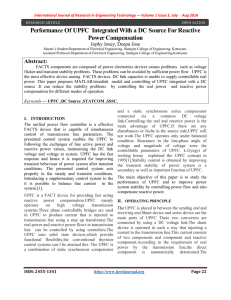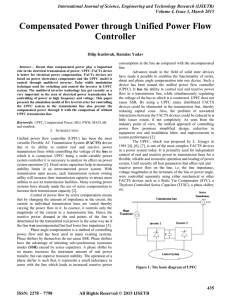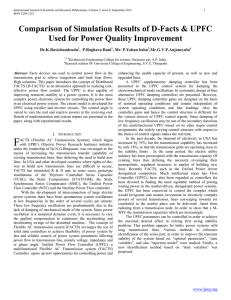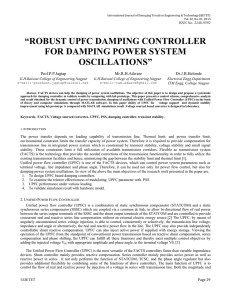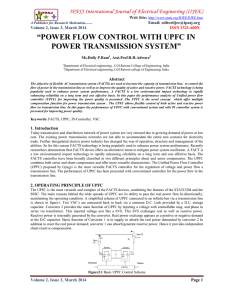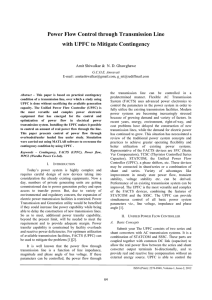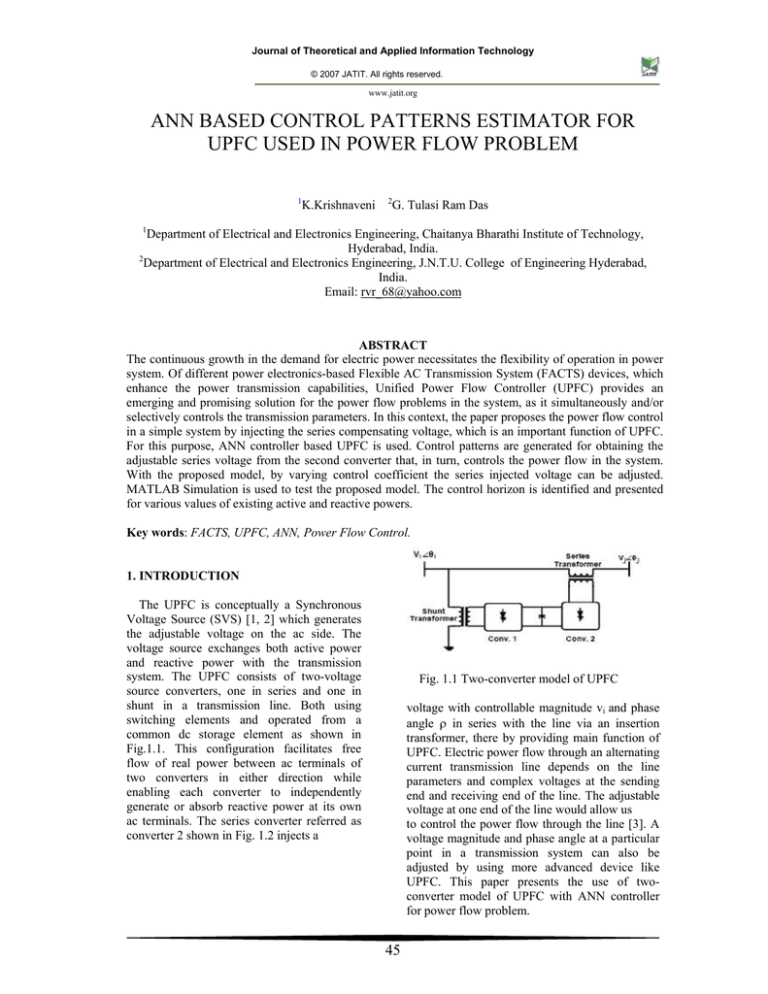
Journal of Theoretical and Applied Information Technology
© 2007 JATIT. All rights reserved.
www.jatit.org
ANN BASED CONTROL PATTERNS ESTIMATOR FOR
UPFC USED IN POWER FLOW PROBLEM
1
K.Krishnaveni
2
G. Tulasi Ram Das
1
Department of Electrical and Electronics Engineering, Chaitanya Bharathi Institute of Technology,
Hyderabad, India.
2
Department of Electrical and Electronics Engineering, J.N.T.U. College of Engineering Hyderabad,
India.
Email: rvr_68@yahoo.com
ABSTRACT
The continuous growth in the demand for electric power necessitates the flexibility of operation in power
system. Of different power electronics-based Flexible AC Transmission System (FACTS) devices, which
enhance the power transmission capabilities, Unified Power Flow Controller (UPFC) provides an
emerging and promising solution for the power flow problems in the system, as it simultaneously and/or
selectively controls the transmission parameters. In this context, the paper proposes the power flow control
in a simple system by injecting the series compensating voltage, which is an important function of UPFC.
For this purpose, ANN controller based UPFC is used. Control patterns are generated for obtaining the
adjustable series voltage from the second converter that, in turn, controls the power flow in the system.
With the proposed model, by varying control coefficient the series injected voltage can be adjusted.
MATLAB Simulation is used to test the proposed model. The control horizon is identified and presented
for various values of existing active and reactive powers.
Key words: FACTS, UPFC, ANN, Power Flow Control.
1. INTRODUCTION
The UPFC is conceptually a Synchronous
Voltage Source (SVS) [1, 2] which generates
the adjustable voltage on the ac side. The
voltage source exchanges both active power
and reactive power with the transmission
system. The UPFC consists of two-voltage
source converters, one in series and one in
shunt in a transmission line. Both using
switching elements and operated from a
common dc storage element as shown in
Fig.1.1. This configuration facilitates free
flow of real power between ac terminals of
two converters in either direction while
enabling each converter to independently
generate or absorb reactive power at its own
ac terminals. The series converter referred as
converter 2 shown in Fig. 1.2 injects a
Fig. 1.1 Two-converter model of UPFC
voltage with controllable magnitude vi and phase
angle ρ in series with the line via an insertion
transformer, there by providing main function of
UPFC. Electric power flow through an alternating
current transmission line depends on the line
parameters and complex voltages at the sending
end and receiving end of the line. The adjustable
voltage at one end of the line would allow us
to control the power flow through the line [3]. A
voltage magnitude and phase angle at a particular
point in a transmission system can also be
adjusted by using more advanced device like
UPFC. This paper presents the use of twoconverter model of UPFC with ANN controller
for power flow problem.
45
Journal of Theoretical and Applied Information Technology
© 2007 JATIT. All rights reserved.
www.jatit.org
system as shown in figure 2. Some other lines
also may be connected parallel in with the above
line. Assuming that receiving end voltage Vr of
the line maintained constant. When the line is
represented by a two-port network with
generalized ABCD constants, The active power
Pr and reactive power Qr at the receiving end of
the line can be written as [4]
Fig.1.2. Conceptual representation of UPFC
with two-machine system
Pr =VsVr/B cos (βs - δs + δr) - AVr2/B cos (β - α) --(1)
Basically, the UPFC control system can be
divided functionally into two units concerning
internal and external controls [1]. The internal
control unit operates the two inverters so as to
produce the commanded series injected
voltage, and simultaneously draws the desired
shunt real and reactive currents from the shunt
inverter by controlling a proper output voltage
at its AC terminals. On the other hand, the
external control unit is responsible for
generating the proper voltage commands for
the internal control unit so as to regulate the
controlled system variables, real and reactive
power flows; to meet the desired values.
However, the process in the external control
unit is normally a tedious task; it takes a long
time to solve a set of non-linear equations so
as to get the input reference voltages
requested by the internal control unit of the
UPFC.
Over the last two decades, ANN has
gained a lot of appreciation from many
engineering fields. The electric power industry
is no exception. With the advent of powerful
and cheap computers, digital control is being
used in a growing number of power system
applications. Many new effective algorithms
have been developed and implemented in real
time. Artificial Neural Network controller
(ANNC) is a new control approach with a
great potential for real-time applications.
In order to realize a real time control
of the power flow in steady state, an ANN
based control algorithm is proposed in this
paper to solve the above mentioned problem.
Instead of using the iteration method, a trained
Neural Network can be used as an estimator to
predict the internal control variable ( K ) in
the UPFC system.
Vs
Transmission Line
Vr
Pr+jQr
Fig. 2. Representation of a two bus system
Qr= VsVr/B sin (βs - δs + δr)- AVr2/B sin (β - α)-(2)
Here Vs= Vsejδs,
Vr= Vrejδr
A=Aejα and B=Bejβ
(δ=0)
Without any UPFC the active and
reactive power flows through the line are fixed
and are defined by the (1) and (2) respectively.
However UPFC can control the power flow
through the line, which is described in the next
section.
3. POWER FLOW CONTROL WITH UPFC
Consider a UPFC placed at the sending
end of the line as shown in figure 3.1 .The UPFC
can be represented by series injected voltage and
a shunt current Ii as shown Fig.3.1. Note that Vi
is fully controllable and can be expressed as
Vi= Vi ej(δs+γ)
where Vi≤ Vimax and 0≤ γ ≤ 360o
In this case , the sending end final voltage
Vs f= Vs + Vi------(3)
2. POWER FLOW CONTROL
The phasor diagram of (3) is shown by the
dotted circle in figure 3.2. By knowing Vsf, the
active and reactive power at the Receiving end
Consider transmission line that is
connected between two buses of a power
46
Journal of Theoretical and Applied Information Technology
© 2007 JATIT. All rights reserved.
www.jatit.org
can be calculated from (1) and (2)
respectively, after replacing Vs by Vsf. The
Current Isf in figure can be written as [1]
singularity results were inaccurate. To avoid this
P and Q are scaled to maximum 1000 and a
minimum 100.
Isf = CVr+DIr= CVr+D (Vsf-AVr)/B ------------(4)
Example: P=389W,
Pscaled = (max-P)/(max-min)
= (1000-389)/1000-100)
Transmission Line
Vs
Vi
Ii
Vr
Isf
Similarly, Q = 315var
Qscaled = (max-Q)/(max-min)
= (1000-315)/(1000-100)
They mutually correspond to a given set
of real and reactive power flows (P, Q) which are
practically the real and reactive power flows
controlled by UPFCs. The biggest advantage of
using ANN based estimators in the control
scheme is that the time during the recall process
of a trained estimator is almost negligible in
comparison with the time taken to perform an
iteration program to solve a set of non-linear
equations introduced in [5] .
Theoretically, there are number of
Neural Networks which can be used to achieve
this control requirement. A multi-layer feed
forward Neural Network has an input layer, an
output layer and several hidden layers. This type
of ANN is suitable for mapping a set of input
patterns onto a set of output patterns and it is used
in this study
Vsf
Fig .3.1Transmission line with UPFC at
sending end
Vsf
Vi
Vs
Fig. 3.2. Phasor Diagram
4. ARTIFICIAL NEURAL NETWORK
CONTROLLER
The control circuit generates
coefficients (Ki) that must be multiplied with
output of the dual converter
to get the
component of voltage to be added in series to
supply voltage to compensate for variation in
real and reactive powers.
Intelligent controller using artificial
neural network is used to obtain the
coefficients. Neural network is trained for
specified values with in the range.
Trained
neural network intelligently returns the
coefficients for a given alpha, P and Q with in
the range.
During training process when active
power and reactive power in the data base
expressed in terms of W that is, P= 389W,
Q=315W, etc., as the matrix was close to
Fig.4. Simple Neural Network model
to examine the feasibility of applying the
proposed ANN Based Control Algorithm
(ABCA) in a practical control scheme[6]. The
basic idea of ABCA is based on the fact that
when the configuration of a power network
maintains the same topology then the
relationships between the power flow and losses
47
Journal of Theoretical and Applied Information Technology
© 2007 JATIT. All rights reserved.
www.jatit.org
patterns and the patterns of control variables
in UPFCs will be conserved. Therefore, the
trained ANN based estimator is able to
correctly predict a set of proper control
variables for the internal controllers of UPFCs
to meet a certain control goal. In this paper,
only the case of steady state power flow
regulation subjected to the minimization of
system losses and the support of voltage
profile is presented .
The proposed UPFC based on ANN
controller is simulated using MATLAB software.
By inputting the Pr, Qr and firing angle ϕ the
initial sending end voltage Vsi without controller
is obtained. After multiplying with a control
variable K generated by the ANN controller the
corrected value of sending end voltage Vsf is
obtained which is shown in Table 1.This voltage
will be almost equal to the referred value of
sending end voltage Vs. Control variables are
obtained for various ranges of active and reactive
powers by keeping firing angle ϕ constant.
Fig. 6.(1)-(2). show a set of the performance
graphs during training of ANN for given Pr, Qr
and firing angle ϕ in the UPFC system installed
in line.
5. ANN BASED CONTROL VARIABLES
ESTIMATOR
As mentioned in the above section,
the ANN based control variables estimator is
used to predict a set of control variables for
the internal controller of the UPFC system.
For training the neural net, a set of training
patterns are required. In this study case, these
patterns are composed of a set of inputs given
below of the external control unit in the UPFC
control system.
TABLE 1
COMPARISON OF SENDING END VOLTAGE
WITH AND WITHOUT UPFC
Range of alpha=0 to 1.57
Range of Real power=375 to 425
Range of reactive power=300 to 360
Function inputs=alpha, Pr, Qr
Function output=Control Coefficient.
Fifty seven training patterns are
obtained from the conventional open loop
control. At each simulation step, the best
voltage profile must be provided as well as the
minimum system losses must be reached by
properly selecting the best combination of
control variables for UPFC. The training and
testing processes in this study are carried out
by using back propagation algorithm. The
neural network learning algorithm in general
view is given below. Given n training
instances,
1. Initialize the network weights, set
I=1 Present the ith
instance to the
network on the input layer.
2. Obtain the activation levels of the
output units using the inference
algorithms. If the network per forms
the predefine standard (or the
stopping criterion)then exit.
3. Update the weights by learning rule
of the network.
4. If i=n then reset i =1 otherwise
increment i by 1. Go to step 2.
Pr
Vsi
Vsf
K
375
380
541.044
543.38
560.6323
560.6391
2.01
1.76
385
545.78
560.6396
1.51
390
548.19
560.6430
1.2
395
550.61
560.6581
1.01
400
553.04
560.6632
0.7641
410
557.94
560.6426
0.2683
415
560.41
560.6360
0.222
425
565.37
560.6299
-0.465
Here
Pr=receiving end real power (variable)
Qr=315,Firing angle=63deg. (made fixed)
Vs= set value=560volts
Vsf= Vs final i.e after correction
K=control
coefficient
obtained
from
MATLAB Simulation
6. SIMULATION RESULTS
48
Journal of Theoretical and Applied Information Technology
© 2007 JATIT. All rights reserved.
www.jatit.org
[2] Song, Y. H. and Johns , A. T. Flexible AC
Transmission Systems (FACTS). IEEE
Stevenage: UK. 1999
[3] Haque, M. H. Power Flow Control and
Voltage
Stability
Limit:
Regulating
Transformer versus UPFC. IEEE Proc. C
Gener.Transmis3. Distrib, 2004.
[4] H. Sadat , Power System
Singapore: McGraw-Hill, 1999.
[5]
Fig 6.1 Training of Neural network before
goal was met
Analysis,
A. Nabavi-Niaki , et al. Steady State and
Dynamic Model of Unified Power Flow
Controller (WFC) For Power System Studies .
IEEE Transactions on Power Systems, Vol.
11, No. 4, November 1996, pp, 1937-1943 .
[6] K. L. Lo ,T. T. Ma, J. Trecat ,M. Crappe, A
novel power flow control concept using ANN
based multiple UPFCs scheme. Energy
management and power delive
Fig 6.2. Training of Neural network after goal
was met
7. CONCLUSIONS
In this paper a novel control concept
using ANN based estimator in the external
control unit of the UPFC system has been
presented. Simulation results show that the
trained ANN based estimator is able to
correctly estimate the patterns of UPFC
internal control variables. They are mutually
mapping to a set of corresponding power flow
patterns, which are based on satisfying the
condition that the system voltage profile must
be supported and the system losses must be
minimized at the same time.
8. REFERENCES
[1] Hingorani, N. G. and Gyugyi, L.
Understanding of FACTS. IEEE Press,
New York. 1999.
49


